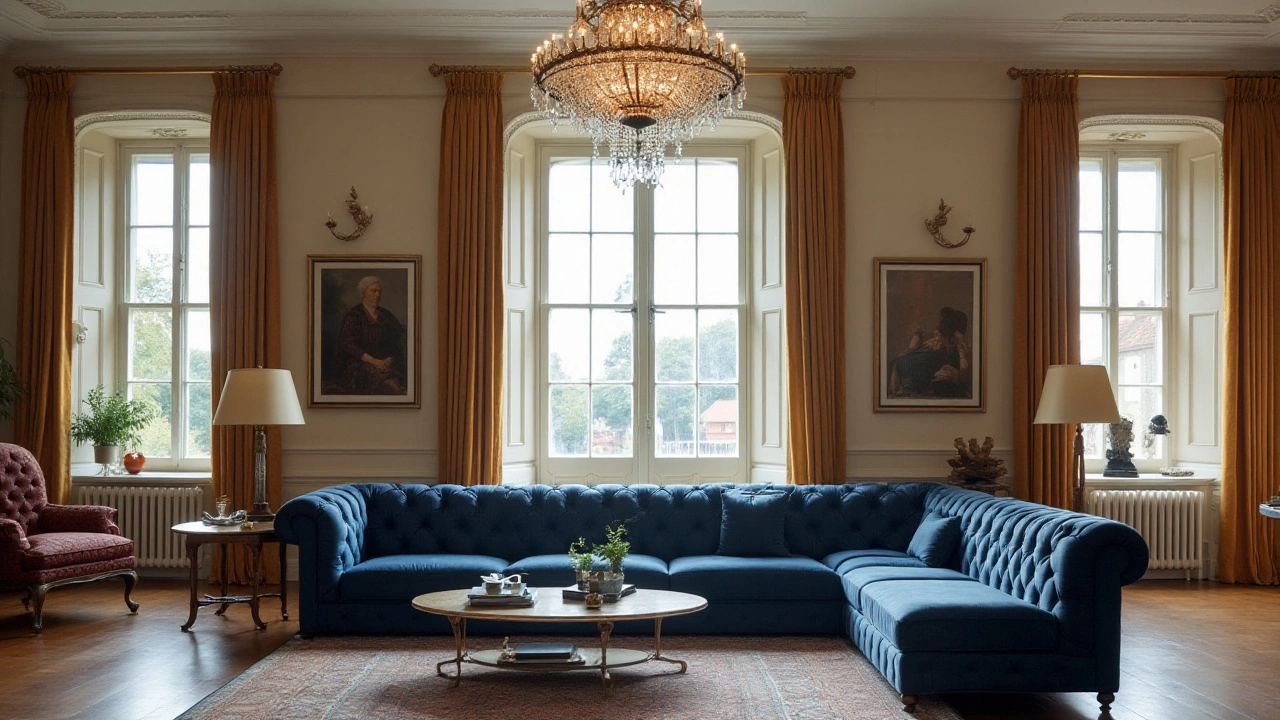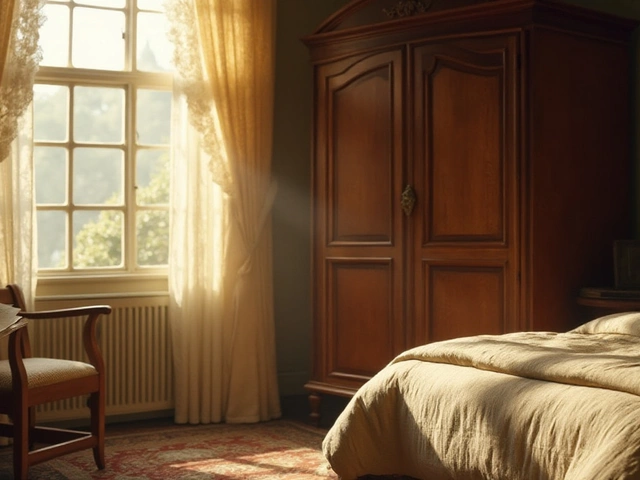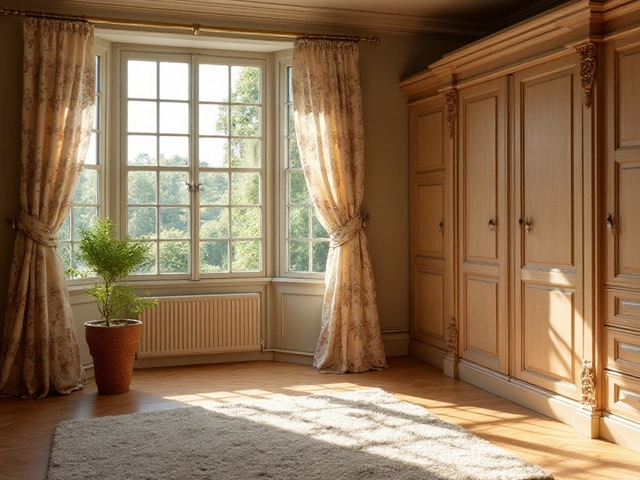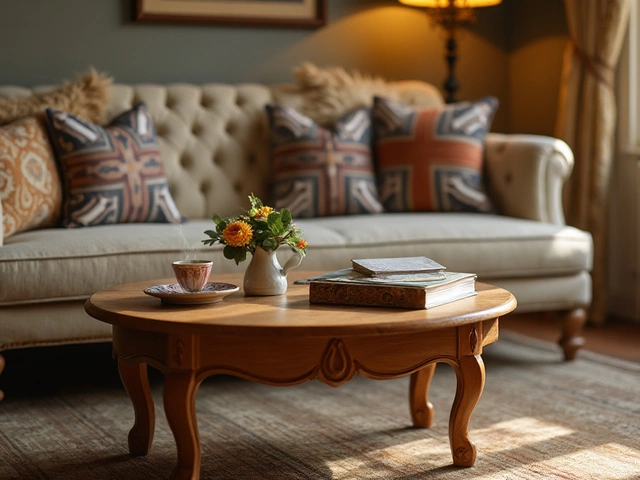When it comes to creating a space that feels luxurious and well-designed, the color of your furniture can make all the difference. The right hues not only set the tone but also subtly signal sophistication and quality. This exploration helps you understand which colors naturally convey an air of richness and opulence, allowing even the simplest rooms to come alive with elegance.
Incorporating colors into your furniture selection isn't just about trending tones. It's about finding the balance between current styles and timeless classics that offer a perennial sense of wealth and style. From deep jewel tones to soft pastels, the palette of your furniture could be the key to ensuring your spaces reflect your taste, personality, and status. Whether you're introducing new pieces or refurbishing existing ones, understanding the impact of color is essential in your journey towards a luxurious home.
- Understanding Luxury in Color
- Timeless Neutrals
- Bold Jewel Tones
- Sophisticated Pastels
- Textures and Finishes
- Implementing and Accessorizing
Understanding Luxury in Color
Did you know that the perception of luxury in furniture color is deeply rooted in our visual experiences and cultural perceptions? Different colors evoke varying emotions, subtly impacting how we perceive spaces. Colors that are linked to wealth, sophistication, and opulence often have a profound psychological influence. In designing high-end interiors, furniture colors communicate a message of elegance and exclusivity. Research indicates that specific hues, such as deep blues, rich emeralds, and classic blacks, create an impression of luxury because they symbolize rarity, dignity, and timelessness. The interplay of color theory and its psychological effects is crucial when aiming for an upscale aesthetic.
To delve deeper, it's important to acknowledge how different cultures have associated luxury with certain colors throughout history. For instance, the color purple has been long associated with royalty due to the expensive process of creating the dye in ancient times. Similarly, gold and silver have been synonymous with wealth and status across many societies. More modern associations have tied sleek blacks and elegant greys with contemporary luxury and minimalism. As we select colors for our luxury furniture, it becomes essential to understand these historical connotations and how they continue to influence modern perceptions of extravagance and refinement.
Luxury can often be a fickle concept, heavily influenced by both personal preferences and widespread trends. The allure of luxury often lies in the subtlety of the color choice – a perfect blend that isn't too overt yet doesn't fade into the mundane. According to interior design expert Jane Smith,
"A space's elegance is often whispered through its colors. It's not always the boldest hue that speaks of luxury, but often the subtlest blend that commands attention."Her insights underline the significance of a balanced approach. While choosing upscale design elements, it’s important to maintain harmony between vibrant and neutral tones, ensuring that the chosen shades enhance the overall grandeur of the space without overwhelming it.
The role of lighting also cannot be undermined as it has a drastic impact on how colors are perceived. A color may look regal and luxurious in natural light yet lose its charm in artificial lighting. This is why choosing furniture for a luxurious appeal also involves a keen eye on the space's lighting. Test different shades in various lighting conditions before making a final decision. Consider consulting a color expert who can provide tailored advice based on your space's specific lighting and architecture. This approach ensures that the chosen colors truly highlight the magnificence and sophistication of your interior decor.
Timeless Neutrals
When discussing the elegance that luxury furniture can embody, few color palettes are as universally admired as the timeless neutrals. These shades offer a sublime blend of subtlety and style, providing a backdrop that is both elegant and versatile. Neutrals are often seen as the unsung heroes of interior decor, revered for their ability to make a room look expansive, serene, and sophisticated all at once. From sandy beige and taupe to the silvery elegance of cool greys, neutral tones allow for an understated beauty that speaks volumes in its simplicity.
Neutrals are not just about browns and whites; they spread across a spectrum that includes shades such as soft creams, light greys, and muted greens. Each of these colors can influence the atmosphere of a room differently, offering warmth when infused with red or yellow undertones, or cooling it down with hints of blue. Such colors have the unique ability to blend effortlessly with other bolder hues or stand alone for a minimalist chic appearance. This adaptability is why many upscale furniture stores and designers vouch for these hues in their catalogues. As the interior designer Nate Berkus once mentioned,
“Your home should tell the story of who you are, and be a collection of what you love.”
Color theory also supports that certain neutrals have the ability to evoke specific emotional responses, making them ideal for different living areas. Consider a plush sofa in a creamy beige set against dark, grooved wood flooring; not only does it provide a regal touch to the living room, but it also serves as an open invitation for colorful cushions and throws. In dining rooms, dove grey or slate can bring a sense of quiet sophistication, perfect for intimate gatherings where the focus remains on conversation and cuisine rather than garish distractions. For those seeking to achieve an upscale look, the seamless integration of elegant colors with carefully curated textures becomes an appealing avenue.
Neutral furniture doesn’t just look airy and chic, it also ages gracefully. Unlike more vivid shades that might date or require frequent updates, neutrals maintain their elegant appeal over time. This timeless aspect makes furniture in these shades a wise investment, offering an extended lifecycle that outlasts more trendy options. Additionally, homeowner surveys frequently cite neutral color schemes among the top reasons real estate spaces achieve higher market valuations. In this way, one might argue that pairing simplicity with functionality is the epitome of tasteful design, ensuring that the home remains not only beautiful but also valuable.
When designing with neutrals, it can also be advantageous to think in layers. Textures become particularly important in this context, helping prevent the space from feeling flat. Mixing materials like linen, velvet, and even metallic accents can add dimensionality and increased visual interest. Common practice suggests beginning with a main piece, like a luxury furniture settee in a soft ivory, and then adding layers through textured rugs, smooth ceramics, and metallic lamp bases. Not only do these elements bring the room together, but they also invite a tactile experience that is both rich and inviting. Neutral tones with texture are a trend that consistently surfaces at interior design exhibitions worldwide.

Bold Jewel Tones
When you think of luxury and opulence, bold jewel tones often come to mind. These rich colors, inspired by precious stones, have the power to transform a mundane space into one that feels regal and sophisticated. Colors such as emerald green, sapphire blue, and deep ruby red effortlessly exude a sense of richness and refinement. These tones work magic when applied to key furniture pieces, instantly making them stand out and serve as focal points within a room.
The allure of jewel tones lies in their intensity and depth. Unlike softer color palettes, jewel tones demand attention and make a statement, which is exactly what you need when aiming for an elegant ambiance. Emerald green, for instance, can evoke feelings of wealth and abundance, pairing beautifully with gold accents and dark wood finishes to create a cohesive, luxurious look. Similarly, a deep sapphire blue sofa can act as the centerpiece in a living room, drawing in the eye and offering a sense of calm and confidence.
Strategically incorporating these colors can also have psychological benefits. According to color psychology, blues and greens promote tranquility and poise, making them ideal for spaces designed for relaxation or reflection. In contrast, ruby reds can inject energy and passion into a room, perfect for dining areas where you want lively conversations to thrive. For those looking to strike a balance, consider pairing strong jewel tones with neutral backgrounds to let these colors truly shine without overwhelming the space.
"Jewel tones have a timeless quality that speaks to the enduring value they represent," shares interior designer Samantha Peters. Her extensive experience in upscale decor highlights how these colors are not just passing trends, but staples in creating sophisticated spaces.
When working with luxury furniture, texture can further amplify the effect of jewel tones. Velvet fabrics, with their plush look and feel, are particularly suited to these colors. They reflect light differently, adding depth and a dynamic quality to the furniture piece they adorn. In addition, materials like marble and brushed metal can complement jewel tones beautifully, offering an additional layer of visual interest and elegance. Consider jewel tones as the main actor on the stage of your room’s decor, with other colors and textures playing supporting roles, enhancing the drama and luxury that these bold hues naturally provide.
Pairing and Accessories
Integrating jewel tones into your home doesn’t stop at the furniture itself. Accessories like throw pillows, area rugs, and artwork can echo the boldness of your selected palette. When paired thoughtfully, they can extend the luxurious theme of your bold jewel-toned centerpiece, creating a harmonious and cohesive environment. A well-placed sapphire blue vase or an emerald green curtain can pull the look together. Such touches ensure that the interior decor feels intentional and well-curated, suggesting attention to detail and a cultivated taste.Given their dramatic nature, jewel tones also work best in moderation. An entire room drenched in these hues can be overpowering, but using one or two key pieces allows them to be both impactful and digestible. Bold-colored furniture doesn't just reflect your style; it reflects confidence and a clear design vision. Whether making a large investment in a statement sofa or just starting with a smaller chair or accent table, leaning into these colors can transform your living space into an upscale retreat without needing a total overhaul.
Sophisticated Pastels
In the realm of interior decoration, sophisticated pastels stand as a testament to subtlety meeting style. These hues, often perceived as gentle and calming, possess an understated elegance that can transform any living space into a serene retreat. Delicate shades such as powder blue, blush pink, and mint green aren't just for nurseries or Shabby Chic themes; they have matured into colors that convey a quiet yet definitive luxury.
The allure of pastels lies in their versatility. Unlike their bold counterparts, pastels have the magical ability to adapt and blend into various settings without overpowering the space. This makes them ideal for creating a sophisticated atmosphere that feels both exclusive and welcoming. Pastels can imbue a room with light and space, making it feel larger and airier, while simultaneously bringing warmth and color that feels tailored rather than generic. When paired with luxury furniture, pastels enhance the richness of the textures and materials, spotlighting the craftsmanship and quality that might otherwise go unnoticed.”
A critical factor in the success of pastel tones is their pairing with the right materials and finishes. This includes opulent fabrics like velvet or polished metals such as gold and brass. Velvet couches in soft peach or champagne shades stand out without shouting, especially when accented with gold-rimmed side tables or brass floor lamps. These combinations not only provide textural divergence but also emphasize indulgence through contrast. As Marie-Hélène de Taillac, a renowned jewelry designer, once said, “Pastels are not just the bridge between warm and cool— they are the very spectrum of elegance.”
Jewel tones, while strong and saturated, often overpower smaller or less sunlit rooms, making them feel enclosed. Pastels, by contrast, reflect more light. This attribute makes them perfect companions for muted outdoor light during the short winter days or in city apartments with limited natural light. Stylish homes in urban environments benefit from this color choice as they ensure the interiors remain luminous and spacious. The subtlety of pastels also means that they can exist within modern minimalist designs or amidst opulent classic decor without friction.
Finally, when considering pastel furniture, do not overlook the power of personalization and bespoke choices. Customizing furniture in pastel tones — such as a pale lilac armchair or a soft butter yellow ottoman — can introduce unexpected interest and reflect personal style, transcending conventional design boundaries. Remember, achieving luxury is not just about cost, but the thoughtfulness in selecting colors that resonate and feel intimate.
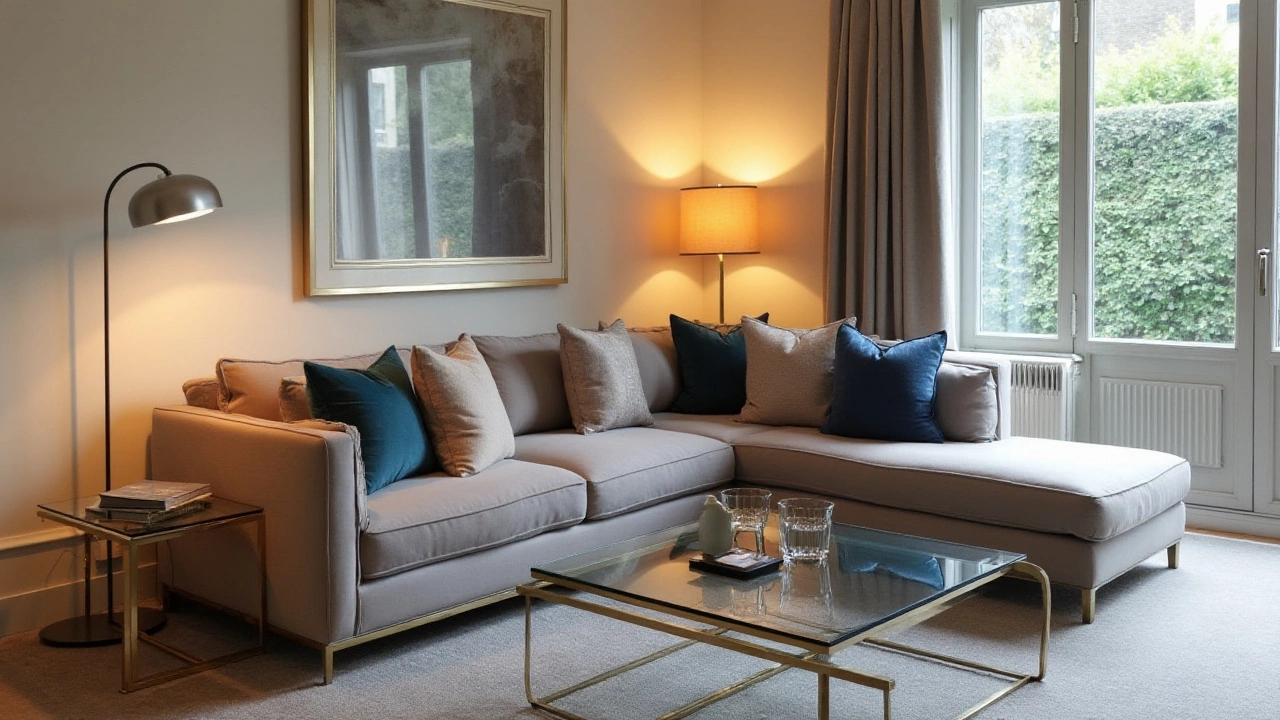
Textures and Finishes
When it comes to furniture, one cannot underestimate the importance of textures and finishes in creating an aura of luxury and sophistication. While the color may catch the eye initially, it is the texture and finish that linger in the memory, providing a tactile experience that speaks volumes about the quality of a piece. Textures such as velvet, silk, and leather have long been associated with opulence, primarily due to their rich feel and association with traditional luxury. Selecting furniture in these materials often results in pieces that not only look expensive but also offer a sense of comfort and warmth that is truly inviting. Imagine a deep sapphire velvet couch that invites you to sink into its plush depths, radiating a quiet confidence and ensuring that it is both centerpiece and conversational piece in any living room.
Beyond the choice of material, the finish can dramatically influence the perceived value of a piece. Consider wood finishes; the gloss of a well-polished mahogany piece exudes a timeless elegance, while a matte finish suggests modernity and understated luxury. High-gloss finishes tend to reflect light, adding brightness to a room while emphasizing the space's sophistication. According to a study by the American Hardwood Export Council, polished wood furniture purportedly boosts interior visual appeal more than any other finish, often lending an impression of careful craftsmanship and attention to detail.
For metals, brushed and antiqued finishes can add depth and character, reminding one of heirlooms and pieces that tell a story. In fact, renowned interior designer Kelly Hoppen notes, "Adding different metal finishes to your furniture collection can bring layers of personality and history to your interiors." Mixing these patinas can create a curated look, making your furniture seem like it has been collected over the years rather than purchased in a rush. This is the hallmark of many elegant homes: a welcoming, curated space filled with personal narratives and subtle hints of upscale design.
Incorporating these textures and finishes isn't just about choosing the most expensive-looking options. It's about striking the perfect balance between visual interest and tactile appeal. For homeowners looking to make their furniture appear more sophisticated, consider using a glass or marble top on coffee tables to add dimension and reflective qualities that work well in natural and artificial lighting. Use a mix of rough textures, like a woven wool throw, against a sleek leather chair to enhance visual and sensory appeal. Such combinations not only make your furniture look more expensive, but they also make your home feel more welcoming and thought-out.
One must remember that creating a lavish atmosphere isn't solely about aesthetics. It's about enhancing the overall experience of a space. They say, "You never get a second chance to make a first impression," and in the world of interior design, this could not be more accurate. Through careful selection and placement of finish-rich, texture-savvy pieces, one can transform any mundane room into a luxurious haven of style, which subtly suggests wealth without speaking it aloud. In this way, textures and finishes play a pivotal role in bringing out the inherent beauty and elegance of your furniture.
Implementing and Accessorizing
Transforming your living space into a realm of luxury and sophistication isn't just about picking the right furniture colors. It's also crucial to understand how to implement these hues and enhance them with strategic accessorizing. The goal is to create a cohesive and elegant atmosphere that doesn't just look rich, but feels inviting and personal. Begin by deciding on a color palette that includes both dominant and accent shades. Once these are established, it's easier to select furniture that complements the overarching theme of the room.
One interesting way to incorporate elegant colors into your home is by using textiles such as curtains, rugs, and throw pillows. These items can serve as subtle color bridges that tie various design elements together, ensuring that no piece appears out of place. For instance, if you've chosen a deep emerald green for a sofa, consider adding a pair of plush, velvet curtains in a complementary jewel tone or a luxurious throw with intricate patterns. The blending and layering of colors should subtly echo each other throughout the space, which often creates a sense of deliberate opulence.
Accessorizing with metallic finishes is another classic technique that elevates room aesthetics. Metals like gold, silver, and brass add a touch of glamor reminiscent of an upscale setting. You might choose picture frames, lamp bases, or small sculptures in these finishes that play into the color story of the room. These accents should be scattered strategically to catch the eye without becoming overwhelming. Implementing such textures not only adds interest and depth but can also highlight the upscale design of your furniture choices.
Consider also the lighting of a room when implementing and accessorizing. Lighting can dramatically impact how colors are perceived and can enhance the luxurious feel you’re aiming for. Opt for layered lighting with ambient, task, and accent options that can be adjusted to emphasize different times of day and moods. Wall sconces or chandeliers with dimmer switches can create an atmosphere that highlights the rich hues of your pieces.
"The details are not the details. They make the design," Charles Eames once said, emphasizing how each small element in a space contributes to its overall feel.
Finally, remember that when implementing these color strategies, cohesion is key. Every piece, from major interior decor items to tiny tchotchkes, should feel intentional and curated. Utilize color charts or digital applications to visualize how different pieces will come together. As you start to see your choices harmonize, the space will naturally emanate that elite, expensive look you're striving for. Adjust and play with elements until you find that sweet spot where the room looks as if it has stepped out of a high-end interior design magazine.
